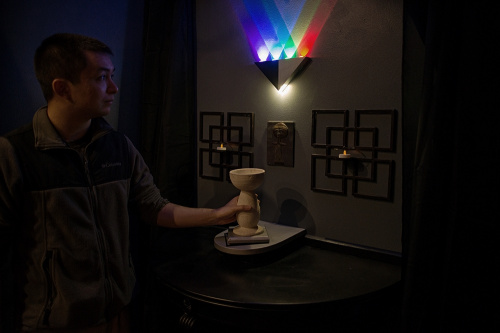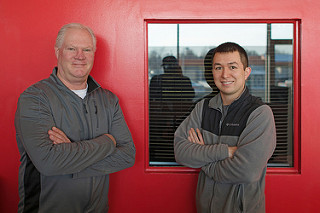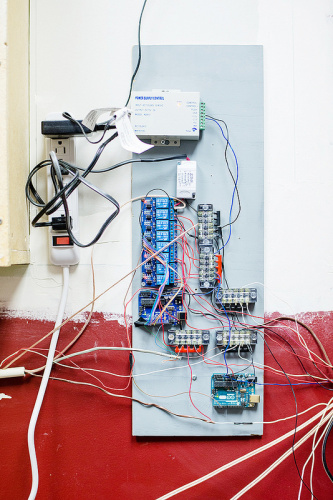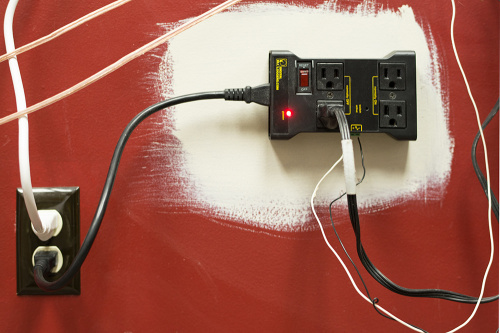If you haven't been introduced to the joy of the escape room, please allow me. Imported from Europe, these immersive group problem-solving puzzles have been appearing all over the country, and if you enjoy critical thinking, mystery, or shouting at your friends, I can't recommend them enough.
On a recent visit to Conundrum Escape Rooms in Arvada, CO, I couldn't help noticing that several of their puzzles relied on some very clever embedded electronics applications. After a lengthy meeting in a back room heavy with incense smoke and creepy medieval chanting, they graciously agreed to allow me to share some of what they created, provided I don't spoil any of the secrets.
Kurt, Luke, and the Chamber of Secrets
If you're unfamiliar with escape rooms, here's a quick breakdown: You and a group of friends (or strangers) are locked in a small room. You have one hour to solve a series of puzzles that will unlock the room and free you. While many of the puzzles are mental or paper-and-pencil tasks, all will eventually result in a physical change in the room, often the opening of a combination lock. This is where the electronics come in.
I'm not telling you what we had to do to open this hatch, so don't bother asking.
Embedded electronics have elevated Conundrum beyond the typical "puzzle reveals combination, opening lock to reveal new puzzle" progression by creating ways for the room to come alive as you unlock its secrets. Correct solutions can change the landscape of the room. The answer to a riddle might be sensor input, rather than a word or sequence of numbers.

I am under no circumstances allowed to disclose what a cool application for RFID this is.
The effect is excellent; the autonomous electronics create seemingly magical interactions between objects in the room and the participants. But with great effects come great design challenges. Reactions to sensor input must be extremely reliable. If a group finds the solution, but doesn't get the response they're expecting, they'll assume their solution is wrong and move on, wasting valuable time. If a light is supposed to come on when they blow into an audio sensor, it must reliably do so for one group per hour, every day.
Pay no attention to the relays behind the curtain.
Relatedly, any electronics used in the room must be durable. Under time pressure, people aren't gentle, and props and furniture in the room take a beating. An expensive circuit that can't stand up to months of regular abuse isn't a good use of time or money.
I'm sure this actuates nothing of consequence.
Puzzle rooms are a fascinating application for embedded circuits, and this style of puzzle circuit also has applications in haunted houses, scavenger hunts, and other projects where an air of mystery is valuable. If you're interested in investigating these circuits yourself, here's a list of Sparkfun parts used in the making of Conundrum's first room:
And there's more on the way! Work has already begun on a second room, with new puzzles so enigmatic that even I haven't been given any insight!*
If you've got puzzle suggestions, parts you would recommend, or stories about related projects, leave them in the comments! There's still time for them to find their way into the new scenario!
*I begged them not to tell me; I want to finish the second room without any hints!










This was a great article! It's amazing how far escape rooms have advanced over the years, and just how fast that they do it! I know we have an escape room, https://www.xscapefactor.com and just in the year we have been in business things progress so fast. We end up making upgrades to all of our rooms every 3-4 months. Thank you to the conundrum guys for giving a behind the scenes sneak peak.
We are a Romania-based escape room company, selling escape game concepts and scenarios. We have clients from all over the world (US, Canada, Europe) and we're looking to expand our business. Check us out at www.thecodex.ro or write us at office@thecodex.ro
I'm working as a consultant for an escape room 'organizer' as well. It's really great to get to build some of the crazy things where you normally would think 'this is not having a practical purpose'. There's a couple of rPi's in each room and in one of them... let's just say that the chessboard is augmented with RFID ;)
The hardest thing is that you can't tell what you've done and how you did it.. because that would ruin the experience for some..
I can't quite make it out in the picture, but who makes that power strip in the last image? I could certainly put a few of those to good use.
I think it's this guy.
I'd really like to see Sparkfun carry this. I don't care much for buying off Amazon.
Looks like the IoT Power Relay from digital-loggers.com
I've been to one of these and they're very cool. I'd highly recommend it if there's one near you